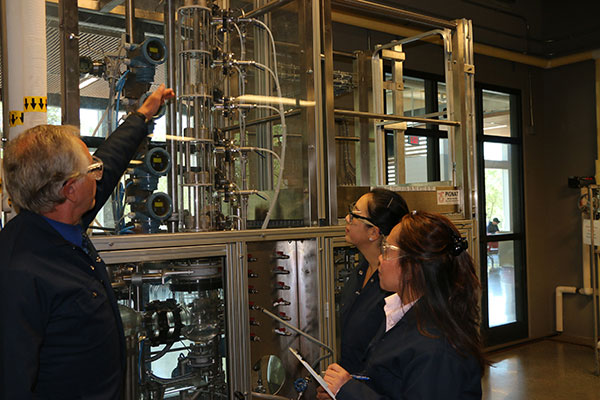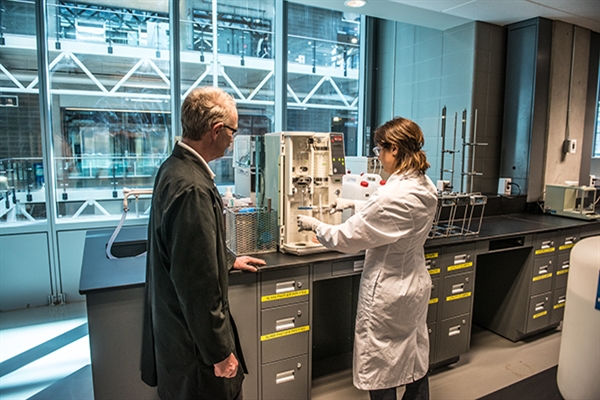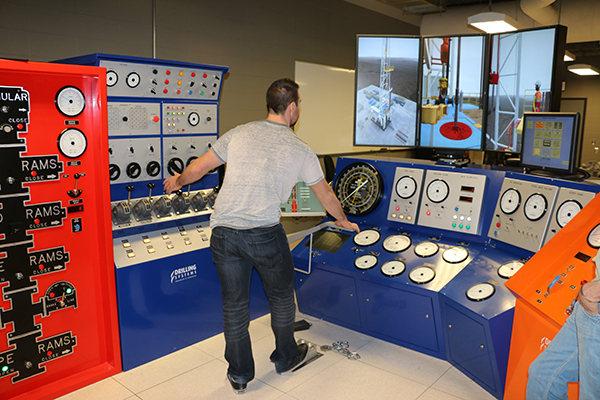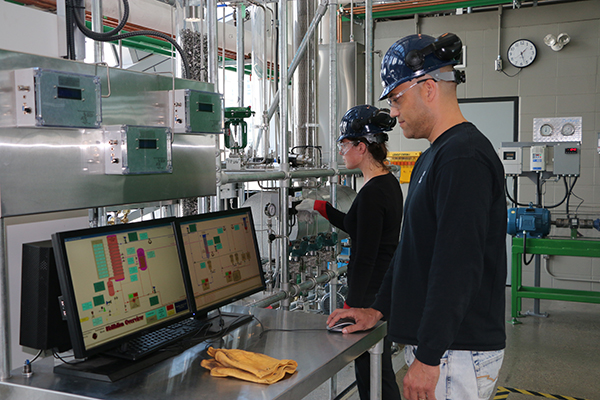On this page:
Overview
We bring all the elements together for a dynamic career with our Chemical Engineering Technology program.
Designed for those who seek a blend of theoretical knowledge and practical skills, this diploma program offers a hands-on learning experience. Our labs are crafted to mirror common equipment and process units, giving you a real-world feel of the industry.
This program offers:
- in-depth theoretical and practical knowledge, delving into the intricacies of unit operations, process simulation and equipment design
- training in the essentials of operating, troubleshooting, maintaining, and designing safe and efficient processing units and plants
- industry-trained instructors with a wealth of knowledge and experience who will guide you through design calculations, process simulation and control, along with crucial aspects of industry safety and environmental engineering
- advanced engineering software training, giving you the tools and skills to excel in the modern chemical engineering landscape
- a capstone project where you'll apply and enhance your skills in a practical setting in sectors such as chemical process engineering, water treatment and others.
Benefit from our strong ties with industry leaders and professionals, with networking opportunities and insights into current industry practices.
This program encourages ongoing learning, ensuring you remain current with the latest trends and technologies in chemical engineering-related fields such as renewable energy development, environmental engineering, biotechnology, pharmaceutical industries, oil and gas processing and beyond.
The versatility of the skills you acquire opens doors to numerous industries. Start your career as a chemical technologist, environmental technician, process engineering technologist or process designer. Opportunities also exist in engineering design, process simulation, technical sales, field operations and environmental sectors.
Alternatively, leverage your education for further studies with transfer options to universities or colleges.
Whether your goal is to jump-start your career or to pave the way for further academic pursuits, our Chemical Engineering Technology program is a great launchpad for your ambitions.
Those in the chemical engineering field tend to be objective, innovative and methodical.
You need:
- attention to detail
- persistence
- accuracy
- problem-solving skills
- the ability to speak and listen well
- leadership and people skills
- the ability to work on a team
- the ability to supervise others.
You should enjoy working with people, analyzing data, math, taking a methodical approach to your work and being innovative.
In your second year, you'll participate in a capstone project where you'll apply what you've learned in your classes to resolve an issue and present your work to an industry partner.
This program is accredited by Technology Accreditation Canada (TAC).
Graduates are eligible to register in the Alberta Society of Engineering Technologists. Periodical registration agreements exist with U.S. and British societies.
After successfully completing this program, you'll receive a SAIT Chemical Engineering Technology diploma.
Careers and opportunities
Each year, SAIT conducts a survey between February and April to determine the employment rate, salary and satisfaction of our newest SAIT alumni.
![]() 73% graduate employment rate
73% graduate employment rate
![]() $57,616 average starting salary
$57,616 average starting salary
Find out more about our graduate employment statistics >
Our graduates may work in the following occupations. Some careers require additional experience and education.
Associated National Occupational Classification (NOC) codes: 22100, 22300, 21101, 22312, 22212, 22110.

Career planning support
Unsure which career path is for you? Here are some recommended career planning resources to help you decide your future.
You can also head to Alberta alis for lots of information about careers in Alberta, including quizzes and labour market information to help you narrow down a path.
Finally, you can take our online career finder quiz, which can help narrow your options based on your current skills and interests.
Courses
The Chemical Engineering Technology diploma requires 61.5 credits (24 courses) to complete.
The program spans two years, with two semesters each year.
| Course | Credits |
|---|---|
|
This introductory chemistry course will review and build upon chemistry fundamentals including periodic table trends, stoichiometry and types of chemical reactions, and organic chemistry. Laboratories will focus on basic laboratory techniques as well as complement theory topics by incorporating error analysis, unit conversions, stoichiometry and percent yield calculations. A basic introduction to WHMIS is also included. |
1.5 |
|
This intermediate chemistry course is divided into three major sections: water chemistry, electrochemistry, and organic colloid chemistry. All topics build on material introduced in Engineering Chemistry I, with special emphasis on industrial applications such as galvanic and electrolytic electrochemical cells, galvanic corrosion, industrial polymer chemistry and oil patch oil-water demulsification. Laboratories reflect industrial processes with bench-scale experiments for reaction rate studies, electroplating, corrosion fundamentals, polymer synthesis and basic oil-water emulsification/demulsification. Pre-requisites:
|
3 |
|
The course emphasizes chemical and engineering systems where reactions take place. Topics include: mass and energy balance, phase behaviour of gas vapour mixtures, real gas relationships, combustion, humidification and mixing of solutions. A process simulator is used to illustrate concepts addressed in class. Pre-requisites:
Corequsites:
Equivalents:
|
3 |
|
This course is based on the concepts and theory previously learned in the chemical engineering technology program. In this computer laboratory course, the student will learn to apply the theoretical concepts learned in chemical engineering calculations, heat transfer and mass transfer for the purposes of designing, modeling and optimizing chemical processes, as well as, performing material and energy balances. Once you have taken this course, you will be able to simulate a variety of different chemical processes. Corequsites:
|
1.5 |
|
This course provides an opportunity to apply the principles learned in the program to the operation of a variety of pilot-plant scale chemical process equipment. Topics include: fluid mechanics, pumps, heat exchangers, phase behaviour, compressor simulation and separating mixtures by distillation, gas absorption and evaporation. An important aspect of your laboratory experience will be to develop a safety-conscious work attitude. Pre-requisites:
Equivalents:
|
1.5 |
|
This course is an examination of the theory and practice of heat transfer with an emphasis on industrial applications. Topics include: heat transfer mechanisms (conduction, convection and radiation), boiling and condensation, heat exchanger (types, design considerations and operations). Pre-requisites:
Corequsites:
Equivalents:
|
3 |
|
The course examines both the theory and equipment involved for the separation of solutions and mixtures. Topics include: distillation, absorption, stripping and liquid/liquid extraction. Calculations by hand as well as computer software are used in solving mass transfer related problems. Corequsites:
Equivalents:
|
3 |
|
This course focuses on basic instrumentation techniques for chemical analysis in the chemical process industries; analytical equipment in both analytical and process laboratory setting using online equipment. Laboratories focus on chemical analytical instrumentation including ultraviolet/visible and infrared spectrophotometry, atomic absorption, emission, gas chromatography, basic QA/QC principles, air quality monitoring theory and analysis. Pre-requisites:
|
3 |
|
Professional Communication and Presentation Skills will introduce learners to the professional writing, collaboration and presentation skills needed to be successful in their chosen field. Learners will gain an understanding of the strategies and competencies required for effective communication with an emphasis on developing the interpersonal skills needed to perform as part of a high-functioning team. Coursework will require learners to work in individual and collaborative settings. Equivalents:
|
3 |
|
This practical course on computer functionality and commonly used industry software covers current productivity software to develop industry-specific solutions in the areas of communication and organization, documentation, data management, analysis, and visualization. In addition, file management techniques and best practices; security considerations such as identifying threats, safeguarding data and intellectual property; and digital citizenship and etiquette are also included. Equivalents:
|
3 |
|
This course is designed to provide students with a general understanding of properties of industrial materials and to provide rational for the selection process. Topics include: properties definition, metallurgy, polymers, ceramics, composites and corrosion. Pre-requisites:
Equivalents:
|
1.5 |
|
This course emphasizes the interpretation and development of flow diagrams and piping isometrics. The use of ISA instrumentation symbols is emphasized. Topics include: freehand sketching, lettering and linework; AutoCAD theory, special features and syntax; 2-D geometry insertion, manipulation, editing, text, layers, colours, and line types. |
1.5 |
|
This course reviews the application of engineering principles in understanding the environmental issues associated with human activity. Topics include: water and waste water treatment, air pollution control, solid waste management, hazardous waste management, oil spill management, climate change and green house gases management and renewable energy technologies. Design concepts for major treatment processes and control equipments are considered. Equivalents:
|
3 |
|
This course explores the principles of fluid mechanics as applied to flowing systems in the chemical process industry. Topics include: unit conversion, viscosity, buoyancy, fluid pressure measurement and calculation, pump affinity laws and specifications, energy calculations (compressible and incompressible flow) pump power requirements and net positive suction head (NPSH). Various fluid flow and pressure measurement devices are evaluated. Equivalents:
|
3 |
|
This course explores chemical engineering as a profession with a general overview of industrial technology, processes and equipment. Topics include: chemical engineering as a career, process equipment, environmental impact, professional ethics and safe work practices. Theoretical concepts are reinforced through related lab activities. |
1.5 |
|
An introduction to process measurement and control, explaining how instrumentation and processes interact. These processes could be in any area of study, such as the oil/gas sector, chemical manufacture, agriculture, and mining, building systems or utilities. Areas of study will include measurement and control of variables such as fluid flow, level and pressure. Specific applications to apply the knowledge to design, operate, troubleshoot measurement and control systems. Equivalents:
|
3 |
|
This course enables the student to apply the basic knowledge of algebra and introductory calculus to resolve applied scientific and technological problems. Applications include linear motion, areas under curves, and volumes of revolution. Equivalents:
|
3 |
|
This course enables the student to apply advanced algebra, integral and differential calculus methodologies to scientific and technological applications. Topics include trigonometric and transcendental calculus, methods of integration, specifically integration by parts, by trigonometric substitution, and by use of tables. Applications include linear motion, areas under curves, volumes of revolution, centroids, moments of inertia, and program-relevant applications. Pre-requisites:
Equivalents:
|
3 |
|
The course will introduce the learner to health and safety fundamentals. Along with personal safety, the learner will be introduced to hazards specific to the oil and gas industry and hazards specific to the use of tools and equipment. From learning about the hazards of hydrocarbons, to information about how to handle and sample hydrocarbons will be covered. Information learned in this course can be applied to many aspects of both work and after work situations. Equivalents:
|
3 |
|
This course examines the processes and surface equipment used in oil and gas production with an emphasis on compression, separation, dehydration and treating. Whenever possible, the actual types of equipment used in the field will be incorporated into the learning. Theoretical concepts are reinforced through related lab activities. |
1.5 |
|
Learners will be introduced to the fundamentals of project management and its application in industry. The focus of this course is to provide project management skills including planning and management of project scope, time, cost, quality, human resources, communication, risk and procurement. Emphasis is on team building and group work. Project management software will also be evaluated. Pre-requisites:
Equivalents:
|
3 |
|
The capstone project is designed to merge the theoretical and technical aspects of the classroom with the real world environment. The learners will be expected to apply learned skills to resolve issues, develop a relevant project and present their report to industry personnel. Pre-requisites:
Equivalents:
|
3 |
|
STAT 245 is an introductory course in data analysis for students in engineering technology programs. Students apply techniques to organize, display, analyze and report data. Outcomes include methods of descriptive and inferential statistics. Students will be exposed to software-based methods in laboratory sessions using industry-grade data. Some advanced topics of analysis are selectable toward the end of the course. |
3 |
|
A basic foundation of thermodynamics is provided with an emphasis on the application of thermodynamics to solve practical problems encountered in chemical engineering. Topics include: first and second law of thermodynamics, phase behaviour and thermodynamic properties of pure substances, application of steam tables and Mollier charts. Theoretical concepts are reinforced through related lab activities. Equivalents:
|
3 |
Progression
You must attain a PGPA and/or a CGPA of 2.0 or better each semester and pass the prerequisite courses to progress through the program.
To qualify for graduation, you must pass all courses, attain a CGPA of 2.0 or better and complete course requirements within the prescribed timelines.
Review our grading and progression procedure >

Explore your options!
Some courses in this program are available through Open Studies. You can complete courses via Open Studies to get a head start on your education, reduce your course load once accepted into a credentialed program, or determine which career path best suits you before you fully commit.
You may also take courses for general interest or personal and professional development.
Admission requirements
Applicants educated in Canada
All applicants must demonstrate English language proficiency and meet all of the following requirements or equivalents:
- at least 60% in Math 30-1 or 75% in Math 30-2, and
- at least 60% in English Language Arts 30-1 or 75% in English Language Arts 30-2, and
- at least 60% in Chemistry 30, and
- at least 60% in Physics 20.
SAIT accepts high school course equivalents for admission for applicants educated outside Alberta.
All applicants who were educated outside of Canada must demonstrate English language proficiency and provide proof they meet the program admission requirements outlined above with an international document assessment. Find accepted educational documents and assessment options.
SAIT may also accept courses completed at certain international post-secondary institutions.

Academic Upgrading
Missing an admission requirement for this program? Upgrade your prior education to help you receive admission into one of SAIT's career programs.

English language proficiency
All applicants must demonstrate English language proficiency prior to admission, including students educated in Canada.
Transfer agreements
At SAIT, we evaluate post-secondary credit you have previously earned and apply it to your SAIT credential. Explore our formal transfer agreements available for this program.
We can evaluate your prior education, even if we don't have a formal agreement in place.
Submit a transfer credit application
There are no formal transfer agreements currently in place for this program.
Transfer options for graduates
Build on the knowledge you’ve learned at SAIT. The opportunity to advance your education at an accredited post-secondary institution may be available.
🔗 Visit Transfer Alberta search tool for all transfer agreements in Alberta (including UCalgary, MRU and BVC).
If there are transfer agreements with other institutions outside of Alberta, nationally or internationally, they will be listed below.
Available intakes
Fall 2025
Start dates:
- Domestic students: Open
-
-
Application deadline: June 30, 2025
-
- International students: Open
-
-
Application deadline: May 30, 2025
-
Costs
2025/26 tuition and fees
The following costs are effective as of July 1, 2025.
The estimated total cost of tuition and fees is based on the suggested schedule of study. Following a modified schedule will impact the fees you pay per semester and may alter final costs.
Domestic students
The program total is based on the estimated amount you will pay if you enter this program during the 2025/26 academic year. The program total amount listed on your letter of admission may appear higher. This amount is your maximum tuition guarantee for the program. SAIT will not exceed this maximum, regardless of changes in tuition and fees between academic years.
Books and supplies cost approximately $1,800 in the first year and $900 in the second year.
This is a bring-your-own-device program with a standard computer hardware and software requirement. See the specific requirements on our computers and laptops page.
Find your booklist on the SAIT Bookstore's website. The booklist will be available closer to the program start date. Can't find your program or course? The bookstore didn't receive a textbook list. Contact your program directly to determine if they're still refining course details or if you're in luck; no textbook purchase is required this term.
Required personal protective equipment (PPE)
The industry-approved PPE you'll need will be discussed during your first few days of classes.
PPE is required in various labs. You'll need a lab coat and CSA-approved safety glasses (with UVEX and side shields) by the first day of class to enter the chemistry labs.

Financial aid
Paying for your education may feel overwhelming, but we have resources and programs that can help, including information about payment options, student loans, grants and scholarships.
Application process
Ready to apply?
Follow our step-by-step guide to submitting a successful application.
Communication during admission
Email is the primary source of communication during the selection process. Ensure your personal email account is managed appropriately to receive our emails, files and communications. We recommend you add the macphail.students@sait.ca domain to your safe senders' list or you risk missing critical email messages.

Begin your application
Apply now using the online application portal.
Ensure you have a valid Visa or Mastercard to pay the non-refundable application fee of $120 for domestic applicants or $175 for international applicants.
Information sessions
Prepare for a strong start in your chosen program or get the details you need to decide your future path.
Our expert staff and faculty are ready to answer your questions and provide information about the following:
- What sets SAIT apart
- An introduction to the program and area of study
- Admission requirements
- Future career paths
- Information on the earning potential and graduate employment rates.
Contact us
MacPhail School of Energy
-
Phone - 403.284.8451
International Student Advising
-
Phone - 403.284.8852
-
Email - international@sait.ca
Subscribe for updates
Your journey starts here! Sign up to get important updates on:
- Energy and environment programs
- Application information
- Relevant news and events

Oki, Âba wathtech, Danit'ada, Tawnshi, Hello.
SAIT is located on the traditional territories of the Niitsitapi (Blackfoot) and the people of Treaty 7 which includes the Siksika, the Piikani, the Kainai, the Tsuut’ina and the Îyârhe Nakoda of Bearspaw, Chiniki and Goodstoney.
We are situated in an area the Blackfoot tribes traditionally called Moh’kinsstis, where the Bow River meets the Elbow River. We now call it the city of Calgary, which is also home to the Métis Nation of Alberta.




